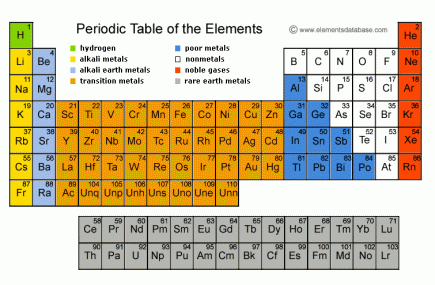Periodic Table – Groups (Families)
The periodic table is organized into periods and families (groups). Each horizontal row is a different period, and each column of the periodic table is a different family. In the sections below, you will learn more about each family.
Alkali Metals
The first family is the Alkali Metals (group 1). The elements in this family are lithium (Li), Sodium (Na), Potassium (K), Rubidium (Rb), Cesium (Cs), and Francium (Fr). The elements in this family are very reactive metals that do not occur freely in nature. These metals have only one electron in their outer shell. As with all metals, the alkali metals are malleable, ductile, and are good conductors of heat and electricity. The alkali metals are softer than most other metals. Cesium and francium are the most reactive elements in this group. Alkali metals can explode if they are exposed to water. Their uses include batteries, ceramics, medicine, agriculture, glass, soap, catalysts, and photocells.
Alkaline Earth Metals
The alkaline earth elements are metal elements found in the second group of the periodic table. All alkaline earth elements are very reactive. Because of their reactivity, the alkaline metals are not found free in nature. The elements of this family are Beryllium (B), Magnesium (Mg), Calcium (Ca), Strontium (Sr), Barium (Ba), and Radium (Ra). Their uses include spacecraft, missiles, aircraft, life forms for bones and shells, flares, fireworks, crimson color, medical applications, and treating cancer.
Transition Metals
The 38 elements in groups 3 through 12 of the periodic table are called “transition metals”. As with all metals, the transition elements are both ductile and malleable, and conduct electricity and heat. There are three noteworthy elements in the transition metals family. These elements are iron, cobalt, and nickel, and they are the only elements known to produce a magnetic field. Their uses include steel, batteries, ceramics, magnets, special glasses, jewelry, photography, and electrical conductors.
Boron Family
The Boron Family is family 13, and has the elements Boron (B), Aluminum (Al), Gallium (Ga), Indium (In), and Thallium (Tl). All elements in the boron family are metals with the exception of boron, which is a metalloid. Some of the uses of the elements in this family include heat resistant alloys, airplanes, soda cans, rat and ant poisons, and detecting infrared radiation.
Carbon Family
The carbon family consists of the five elements that make up Group 14 of the periodic table: carbon (C), silicon(Si) , germanium (Ge), tin (Sn), and lead (Pb). The family is particularly interesting because it consists of one nonmetal (carbon), two metals (tin and lead), and two metalloids (silicon and germanium). (A metalloid is an element that has some of the properties of both metals and nonmetals.) Some uses include steel, filters, glass, semiconductors, coating for steel cans, solder and shielding against radiation, and batteries.
Nitrogen Family
The nitrogen family consists of the five elements that make up Group 15 of the periodic table: nitrogen (N), phosphorus (P), arsenic (As), antimony (Sb), and bismuth (Bi). The elements in this family are strikingly different from each other in both physical properties and chemical behavior. Nitrogen is a nonmetallic gas; phosphorus is a solid nonmetal; arsenic and antimony are metalloids; and bismuth is a typical metal. Some uses include forming most of the atmosphere (nitrogen), fertilizers, detergents, poison, semiconductors, hardens lead, plastics, chemicals, pharmaceuticals and fuses.
Oxygen Family
The oxygen family consists of the elements that make up group 16 on the periodic table: oxygen (O), sulfur (S), selenium (Se), tellurium(Te) , and polonium (Po). The elements are quite different from each other. Oxygen is a gaseous nonmetal; sulfur and selenium are solid nonmetals; tellurium is a solid metalloid; and polonium is a solid metal. Uses include supporting life (oxygen), matches, gunpowder, medicines, photoelectric cells, TV cameras, coloring of glass and ceramics, and thermoelectric devices.
Halogens
The halogens are five non-metallic elements found in group 17 of the periodic table: fluorine (F), chlorine (Cl), bromine (Br), iodine (I), astatine (At). The term “halogen” means “salt-former” and compounds containing halogens are called “salts”. The halogens exist, at room temperature, in all three states of matter:
- Solid- Iodine, Astatine
- Liquid- Bromine
- Gas- Fluorine, Chlorine
Some uses include refrigerants, water purification, bleaches, poisons, necessary in humans (sodium).
Noble Gases
The six noble gases are found in group 18 of the periodic table: helium (He), neon (Ne), argon (Ar), krypton (Kr), xenon (Xe), and radon (Rn). These elements were considered to be inert gases until the 1960’s, because they are not very reactive and do not form compounds readily. They are very stable elements. Some uses include balloons, deep sea diving, lighting, powerful lamps, bubble chambers, and treatment of cancer.
Rare Earth Metals
The rare earths are metals found in the two rows of elements located below the main body of the periodic table. There are two blocks of rare earths, the lanthanide series and the actinide series. Sometimes only the lanthanides, and not the actinides, are classified as rare earths. Several of the lanthanides form during the fission of uranium and plutonium. All of the actinides are dense radioactive metals that are highly electropositive. They tarnish readily in air and combine with most nonmetals.
Sources:
http://www.chemicalelements.com/
http://www.mlms.logan.k12.ut.us/~mlowe/PTJump.html
http://www.enotes.com/uxl-science-encyclopedia/carbon-family
http://www.enotes.com/uxl-science-encyclopedia/nitrogen-family
http://www.enotes.com/uxl-science-encyclopedia/oxygen-family

Recent Comments